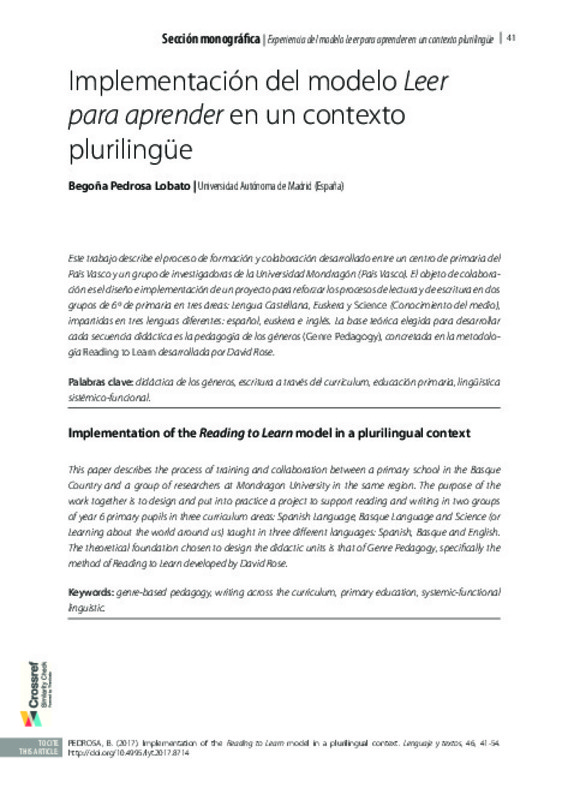CAZDEN, C.B. (2001). Classroom Discourse: The Language of Teaching and Learning, Portsmouth, (2nd ed.): NH: Heinemann.
CENOZ, J. (2005). English in bilingual programs in the Basque Country. International Journal of the Sociology of Languages, 171: 41-56. https://doi.org/10.1515/ijsl.2005.2005.171.41
GIBBONS, P. (2002). Scaffolding Language, Scaffolding Learning: teaching second language learners in the mainstream classroom. Portsmouth: NH: Heinemann.
[+]
CAZDEN, C.B. (2001). Classroom Discourse: The Language of Teaching and Learning, Portsmouth, (2nd ed.): NH: Heinemann.
CENOZ, J. (2005). English in bilingual programs in the Basque Country. International Journal of the Sociology of Languages, 171: 41-56. https://doi.org/10.1515/ijsl.2005.2005.171.41
GIBBONS, P. (2002). Scaffolding Language, Scaffolding Learning: teaching second language learners in the mainstream classroom. Portsmouth: NH: Heinemann.
GIBBONS, P. (2006). Bridging Discourse in the ESL Classroom: students, teachers and researchers. London: Continuum.
HALLIDAY, M.A.K. (1975). Learning how to Mean. London: Edward Arnold. https://doi.org/10.1016/B978-0-12-443701-2.50025-1
HALLIDAY, M.A.K. (2004). An Introduction to Functional Grammar. Third Edition. Revised by C. M.I.M. Matthiessen. London: Hodder Arnold.
MARTIN, J.R. y ROSE, D. (2008). Genre Relations: Mapping Culture. London: Equinox.
MEHAN, H. (1979). Learning lessons. Cambridge, MA: Harvard University Press. https://doi.org/10.4159/harvard.9780674420106
MERCER, N. (1995). The Guided Construction of Knowledge: talk amongst teachers and learners. Clevedon: Multilingual Matters.
PEDROSA, B. y PANGUA, R. (2015). Leer para aprender en educación primaria: una pedagogía basada en géneros. E-Aesla. Enseñanza de lenguas y diseño curricular. Disponible en https://cvc.cervantes.es/lengua/eaesla/pdf/01/14.pdf. Último acceso: diciembre de 2017.
ROSE, D. (2004). Sequencing and pacing of the hidden curriculum: How indigenous learners are left out of the chain. En J.A. Muller y B. Davies Morais (Eds.), Reading Bernstein, Researching Bernstein (pp 91-107). London: Routledge Falmer.
ROSE, D. (2005). Democratising the classroom: a literacy pedagogy for the new generation. Journal of Education, 37, 127-64. 12
ROSE, D. (2011). Reading to learn: Accelerating Learning and Closing the Gap. Teacher training books and DVD. Sydney: Ready to Learn. Disponible en http://www.readingtolearn.com.au. Último acceso: diciembre de 2017.
ROSE, D. y MARTIN, J.R. (2012). Learning to Write, Reading to Learn: Genre, knowledge and pedagogy in the Sydney School. London: Equinox.
SINCLAIR J. y COULTHARD, M. (1975). Towards an Analysis of Discourse. Oxford: Oxford University Press.
VAN LIER, L. (1996). Interaction in the Language Curriculum: Awareness, Autonomy and Authenticity. London: Longman.
VYGOTSKY, L.S. (1962). Thought and Language. Cambridge, M.A.: MIT Press. https://doi.org/10.1037/11193-000
WHITTAKER, R. y ACEVEDO, C. (2016). Working on Literacy in CLIL/Bilingual Contexts: Reading to Learn and Teacher Development. Estudios sobre Educación, 31, 37-55. https://doi.org/10.15581/004.31.37-55
[-]








